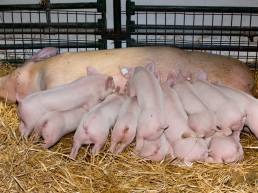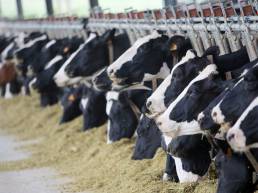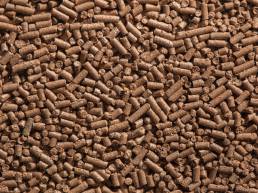Cows are capable of detoxifying limited amounts of mycotoxins in the rumen. This is on condition that the cow’s rumen works properly. However, some mycotoxins have a very negative impact on the rumen flora which decreases the capability to detoxify mycotoxins, but which also interferes with the digestion in particular.
The fact that dairy animals are fed a wide variety of feed materials, such as roughage and concentrates, expose them to various different mycotoxins. Mycotoxins originate from moulds, the best known of these being fusarium moulds on corn and grain. They always grow on the living plant and produce, amongst other things, the substances zearalenone (ZON) and deoxynivalenol (DON). In grass silage it is mainly the various types of Penicillium moulds that cause problems. Toxins from these moulds have an antibiotic effect, which affect the functioning of the rumen bacteria. As a result of this, the entire functioning of the rumen can come under pressure. These moulds are introduced during ensilage and become more active as the silage ages. The growth of mould is a slow process but Penicillium can grow extremely well in silage feed and at a low pH too. Spring conditions in particular (especially the formation of condensation) stimulate the growth of mould and as a result the majority of problems occur from February or March (FinkGremmels, 2011).
For a number of mycotoxins, such as Ochratoxin A, T-2 Toxin, diacetoxyscirpenol and deoxynivalenol, the rumen forms a detoxifying barrier in which the protozoa make the most active contribution. This is why cattle are often thought to be protected against the harmful effects of mycotoxins. However, other aspects should be taken into account before disregarding mycotoxins’ hazardous effects in ruminants. Firstly, the metabolic by-products of some mycotoxins, particularly aflatoxin and zearalenone, are just as or even more harmful than the original molecule (Dänicke et al., 2005). Secondly, it should always be considered that mycotoxins will adversely impact rumen environment and activity, even before having an effect on the animals itself (Fink-Gremmels, 2008). Decreases in ruminal motility, on dry matter, ADF and starch digestibility and microbial growth are some of the impacts seen in animals fed mycotoxin contaminated diets.
The high amount and variety of feedstuffs fed to dairy cattle to achieve the high production they are bred for, accompanied by the poorly incompetent rumen microflora caused by either an unbalanced nutrition (sub-clinical acidosis) or directly by mycotoxins present in the feed, are the perfect combination for mycotoxins to escape microbial degradation and, therefore be absorbed in the intestine at the same extent than that for monogastrics. After absorption mycotoxins will exert their negative impacts at many levels, ranging from decreased performance (Guthrie and Bedell, 1979; Pier, 1981), reproductive problems (Guthrie and Bedell, 1979) to heptatoxic, carcinogenic and immunosuppressive effects (CAST, 2003; Diekman and Green, 1992).
You may also like
Look to the future
January 22, 2019
The new year has already been underway for a few of weeks, but we would still like to wish you all the best for 2019! Numerous factors such as continuously changing legislation, public opinion and Brexit are issues that…
Tox-Aid®: Masked Mycotoxins
January 28, 2017
E.F.S. believes that nature has a solution for everything. Mycotoxins are part of a natural process and it appears that masked mycotoxins are present in crops, feed materials and feed. Maybe you have already heard the…
Mycotoxins
August 16, 2016
Nowadays, adequately controlling the growth of bacteria and fungi is possible, but mycotoxins still pose a risk due to their impact on animal health. In practice, mycotoxins still often seem to be forgotten. However,…
Tox-Aid®: Mycotoxins in dairy farming
July 23, 2016
Mycotoxins are an underestimated problem in livestock. More knowledge has been gained in the past few decades about fungi, mycotoxins and their effects. Therefore fungi are more and more recognised as a problem at…
EFSA: No increase in risk for consumer when formaldehyde is used in animal feed
March 27, 2014
In February 2014, the EFSA published an article on the use of formaldehyde in animal feed. When formaldehyde is used in animal feed, there is no increased intake of formaldehyde by the consumer. Therefore, the EFSA does…








